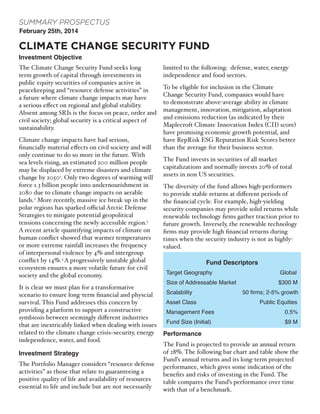
Climate Change Security Fund Seeks Long-Term Growth
- 1. SUMMARY PROSPECTUS February 25th, 2014 CLIMATE CHANGE SECURITY FUND Investment Objective The Climate Change Security Fund seeks long term growth of capital through investments in public equity securities of companies active in peacekeeping and “resource defense activities” in a future where climate change impacts may have a serious effect on regional and global stability. Absent among SRIs is the focus on peace, order and civil society; global security is a critical aspect of sustainability. Climate change impacts have had serious, financially material effects on civil society and will only continue to do so more in the future. With sea levels rising, an estimated 200 million people may be displaced by extreme disasters and climate change by 20501 . Only two degrees of warming will force 1.3 billion people into undernourishment in 2080 due to climate change impacts on aerable lands.2 More recently, massive ice break up in the polar regions has sparked official Arctic Defense Strategies to mitigate potential geopolitical tensions concerning the newly accessible region.3 A recent article quantifying impacts of climate on human conflict showed that warmer temperatures or more extreme rainfall increases the frequency of interpersonal violence by 4% and intergroup conflict by 14%.4 A progressively unstable global ecosystem ensures a more volatile future for civil society and the global economy. It is clear we must plan for a transformative scenario to ensure long-term financial and physcial survival. This Fund addresses this concern by providing a platform to support a constructive symbiosis between seemingly different industries that are inextricably linked when dealing with issues related to the climate change crisis�security, energy independence, water, and food. Investment Strategy The Portfolio Manager considers “resource defense activities” as those that relate to guaranteeing a positive quality of life and availability of resources essential to life and include but are not necessarily limited to the following: defense, water, energy independence and food sectors. To be eligible for inclusion in the Climate Change Security Fund, companies would have to demonstrate above-average ability in climate management, innovation, mitigation, adaptation and emissions reduction (as indicated by their Maplecroft Climate Innovation Index (CII) score) have promising economic growth potential, and have RepRisk ESG Reputation Risk Scores better than the average for their business sector. The Fund invests in securities of all market capitalizations and normally invests 20% of total assets in non US securities. The diversity of the fund allows high-performers to provide stable returns at different periods of the financial cycle. For example, high-yielding security companies may provide solid returns while renewable technology firms gather traction prior to future growth. Inversely, the renewable technology firms may provide high financial returns during times when the security industry is not as highly- valued. Performance The Fund is projected to provide an annual return of 28%. The following bar chart and table show the Fund’s annual returns and its long-term projected performance, which gives some indication of the benefits and risks of investing in the Fund. The table compares the Fund’s performance over time with that of a benchmark. Fund Descriptors Target Geography Global Size of Addressable Market $300 M Scalability 50 firms; 2-5% growth Asset Class Public Equities Management Fees 0.5% Fund Size (Initial) $9 M
- 2. The Climate Change Security Fund seeks an attractive long-term rate of return. Based on financial modeling, returns for one, three, five and 10 years outperform the S&P 500 index anywhere from 9% to 75%. Target Investors and Time Horizon The Fund targets North American and European institutional investors such as endowments, union pension funds and sovereign wealth funds that have an interest in climate change issues. Firms included in the fund are projected to reach maturity by 2020. This is based on financial forecasts that assume investors will continue and expand their climate change security concerns. Metrics for Social and Environmental Impact The fund is designed to engage the sustainability community in a financially-focused security solution to better manage the looming challenges brought about by climate change. The Climate Innovation Index (CII) tracks companies’ achievement in climate-related innovation which has positive, material impacts on society. Assumptions This Fund assumes that the effects of climate change will result in increased recognition of the need to apply both security and sustainability measures to the changing needs and scenarios of global society. Secondly, the Fund assumes that sustainability is going to have an impact on the economy and affect companies negatively or positively. Additionally, at no point will the Fund have more than 5% of the portfolio in cash. The Fund assumes that 95% of funds are invested in stocks. Risks The principal risks of investing in the Climate Change Security Fund, which could adversely affect its net asset value, yield and total return, are risks most generally associated with investment funds like market risk and equities securities risk. This Fund also entails non-U.S. currency risk and the industry-related risks associated with particular events or factors relating to the defense, renewable energy, water, and food sectors, which may increase risk and volatility. 1 Thomas, A. & Rendon, R. (2010). Confronting Climate Displacement. Retrieved from: http:// refugeesinternational.org/sites/default/files?ConfrontingClimateDisplacement.pdf 2 Shindell, D., et al. (2012) Simultaneously Mitigating Near-Term Climate Change and Improving Human Health and Food Security. Science, 335(6065), 183-189. 3 Department of Defense. (2013). Artic Strategy. Retrieved from: http://www.defense.gov/pubs/2013_ Arctic_Strategy.pdf 4 Hsiang, S. M., Burke, M. & Miguel, E. (2013). Quantifying the Influence of Climate on Human Conflict. Science, 341(6151).